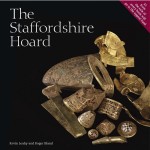The Staffordshire hoard was thought at first glance to be worth at least a million pounds. Now that experts have had a chance to examine the treasure closely, the valuation has skyrocketed to an astonishing 3.3 million pounds ($5.5 million).
The reward will be shared evenly between Terry Herbert, the luckiest metal detectorist of all time, and Fred Johnson, the farmer who owns the land on which the hoard was discovered.
Johnson was magnificently underwhelmed by his good fortune this morning. “Right now I’m just trying to get over the flu, and money is the last thing on my mind. I hope it’ll not make any difference to me. I won’t be putting in a swimming pool anyway, this country is wet enough already.
“I’ve been a millionaire for years anyway,” he chuckled wheezily, “isn’t that what they always say about farmers?”
Friends have told him that if it were sold privately it would be worth tens of millions, but he doesn’t care. He wouldn’t even want that kind of responsibility, he says. He’s just awed by the beauty and workmanship of the pieces. He bought his first suit and went on his first trip to the British Museum to see them on display there.
The panel of experts were just as dazzled by the wonders before them.
Professor Norman Palmer, chair of the treasure valuation committee, whose members pored over 1,800 gold, silver and jewelled objects in a day-long session at the British Museum, said: “It was breathtaking – we all agreed that it was not only a challenge but a privilege to be dealing with material of such quantity, quality and beauty. It was hard to stop our imaginations running away with us.”
Now Staffordshire museums are scrambling to find the money to ensure the hoard stays in the county where it was found. If they can’t raise the full sum, another big money museum certainly will.
 The British Museum has quickly published a book about the hoard, written by written by Kevin Leahy, the archaeologist who cataloged the pieces as they came in to the Birmingham museum, and Roger Bland, head of the Portable Antiquities Scheme. One pound from every sale goes to defray the cost of purchase to keep the hoard where it was found.
The British Museum has quickly published a book about the hoard, written by written by Kevin Leahy, the archaeologist who cataloged the pieces as they came in to the Birmingham museum, and Roger Bland, head of the Portable Antiquities Scheme. One pound from every sale goes to defray the cost of purchase to keep the hoard where it was found.
It would make a great Christmas present for the history lover in your life.
This finding was so exciting to me as a former medievalist–it reminded me of the dragon’s hoard in Beowulf: “Then that huge legacy, gold of the ancient ones, was wound in a spell, so that no one of men must touch the ring-hall…they let the earth hold the wealth of earls, gold in the ground, where it now dwells, as useless to men as it was before…”
Do you know how this compares to the Sutton Hoo stuff, just offhand?
Do you mean in monetary value? Sutton Hoo wasn’t officially valued and its finder donated the treasure to the nation so there’s no easy comparison we can make. I’m sure if Mrs. Petty had chosen to sell the pieces one by one, she would have made more than $5.5 million, but then again, so would the landowner and finder of the Staffordshire Hoard.
Historical value I would say the advantage goes to Sutton Hoo, not so much because of the gorgeous richness of the artifacts, but because it was an intact ship burial done during a nebulous period of English history. What we’ve learned from Sutton Hoo is priceless.
first of all, your blog is really amazing and an excellent piece of design. I really love reading it all the times. thanks for the current article too !! keep posting.
Wow, thank you so much for the kind words. :blush: